Stuart Forster interviews executive chef Jean Pierre Guerin about Rocky Mountaineer food, menu planning for the luxury rail service and the logistical challenges of cooking aboard a train.
Disclosure: The author of this post was invited to travel as a guest of the Rocky Mountaineer, which did not review or approve this article. Some of the links and banners below are affiliate links, meaning, at no additional cost to you, I will earn a commission if you click through and make a purchase.
Talking with chef Jean Pierre Guerin on the Rocky Mountaineer, while watching him work, provided insights into what it takes to feed passengers travelling on the luxury rail service in Canada.
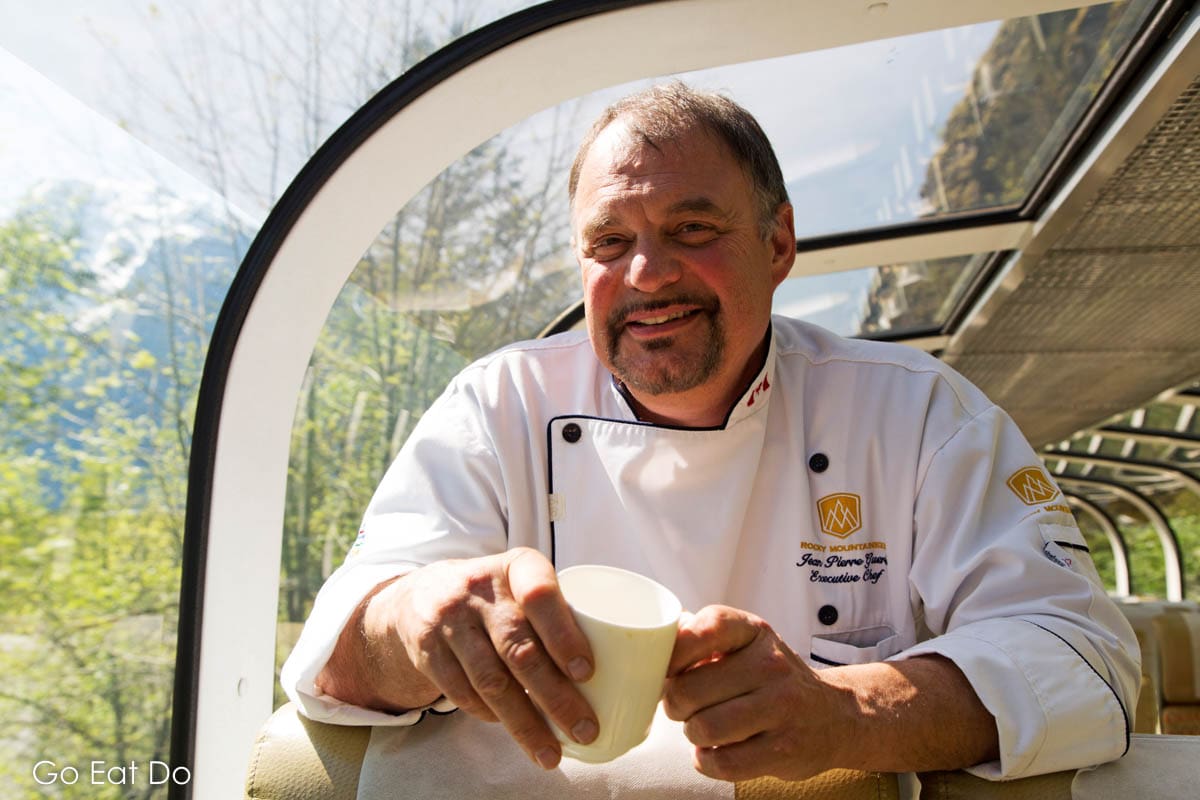
First Passage to the West
Along with outstanding landscapes and customer service, the quality of the food served aboard the Rocky Mountaineer had travellers purring with pleasure during our two-day First Passage to the West journey.
The route involves a scenic journey between Vancouver and Banff with an overnight stay in Kamloops. The scenic train ride in Canada is one of four routes operated by Rocky Mountaineer in North America. Three are north of the border and one, the Rockies to the Red Rocks route, runs between Moab, in Utah, and Denver, Colorado.
I experienced the First Passage to the West in early May. We snaked alongside the Fraser Valley, saw snow-capped mountains towering above Kinbasket Lake and rose through spiral tunnels into the Canadian Rockies. We glimpsed wild longhorn sheep, soaring eagles and even a grizzly bear along the way.
In my view, any chef who can serve food that isn’t eclipsed by that kind of scenery and wildlife deserves plaudits.
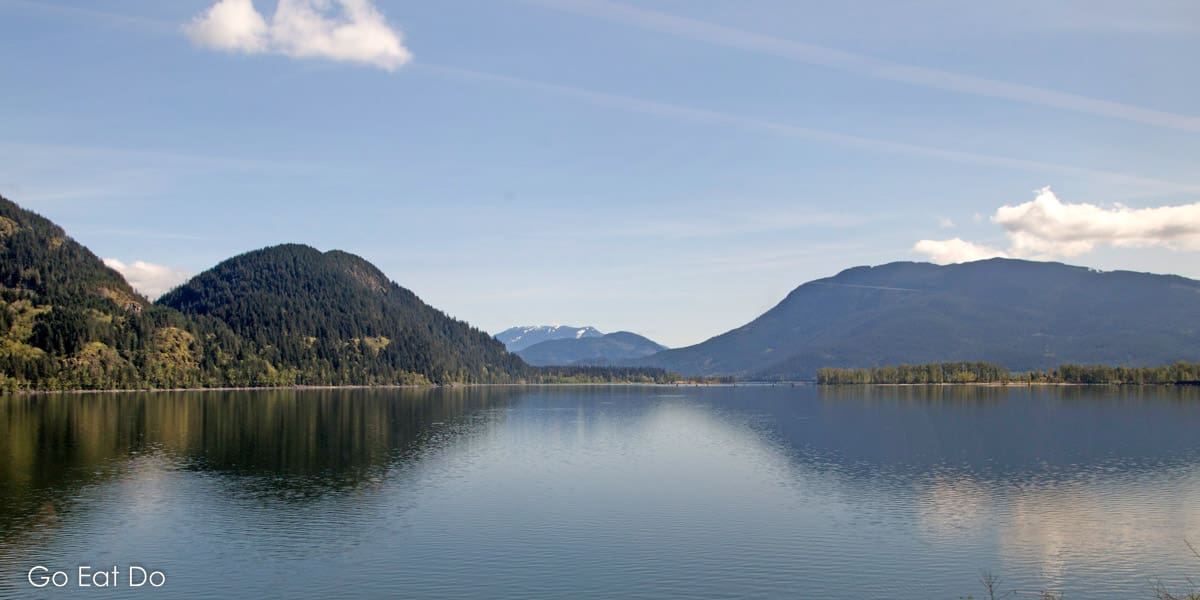
Chef Jean Pierre Guerin
Along with Frédéric Couton, Jean Pierre Guerin is one of the Rocky Mountaineer’s two executive chefs.
Jean Pierre travelled on the train during the first day of the journey, between Vancouver and Kamloops. He set aside time to be interviewed and showed off the narrow galleys where meals are prepared.
“Cooking on board is not that difficult. But you have to take everything, including the kitchen sink,” said Jean Pierre as we sat down to talk.
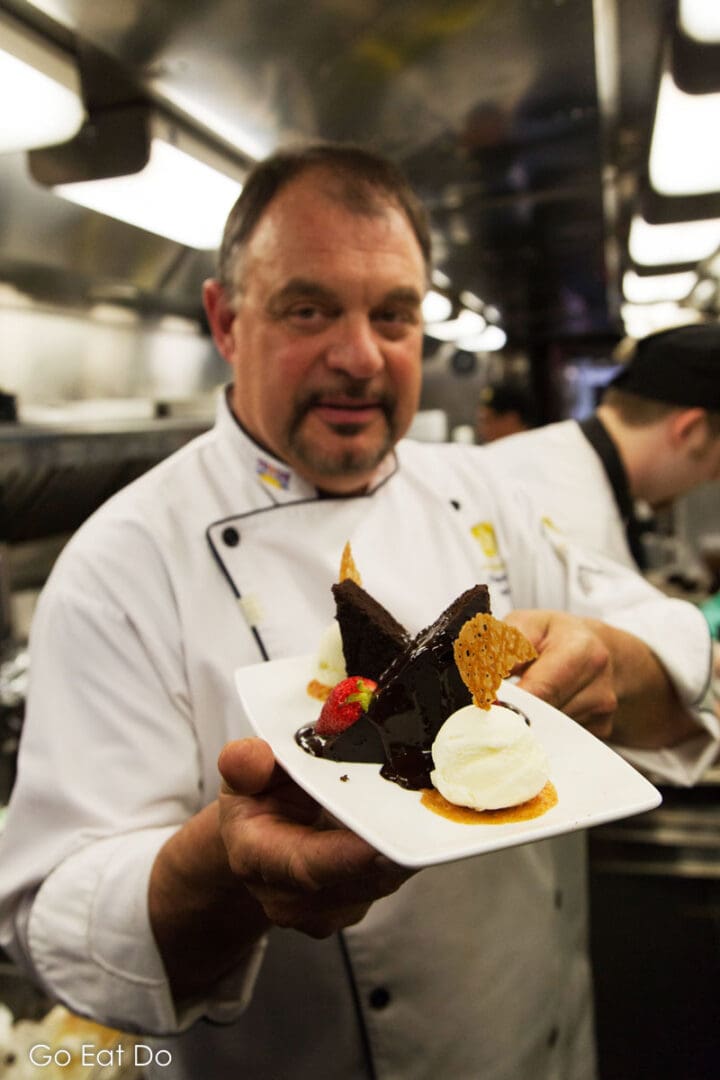
Rocky Mountaineer food
“As we move into the Rocky Mountains we don’t have the luxury of stopping for anything. We have to take two to three days’ worth of supplies. When I say supplies that’s not just the food but the expertise – the chefs have to travel with us, all of the food, and all of the beverages that we will need.
We generate all of our own power on board and have a water supply. We are completely self-sufficient, meaning we can operate in a remote environment and serve the type of food people could expect if travelling in a city,” explained Jean Pierre.
The presentation of the dishes in the GoldLeaf dining carriage was exquisite, catering to the high expectations of discerning travellers from around the world.
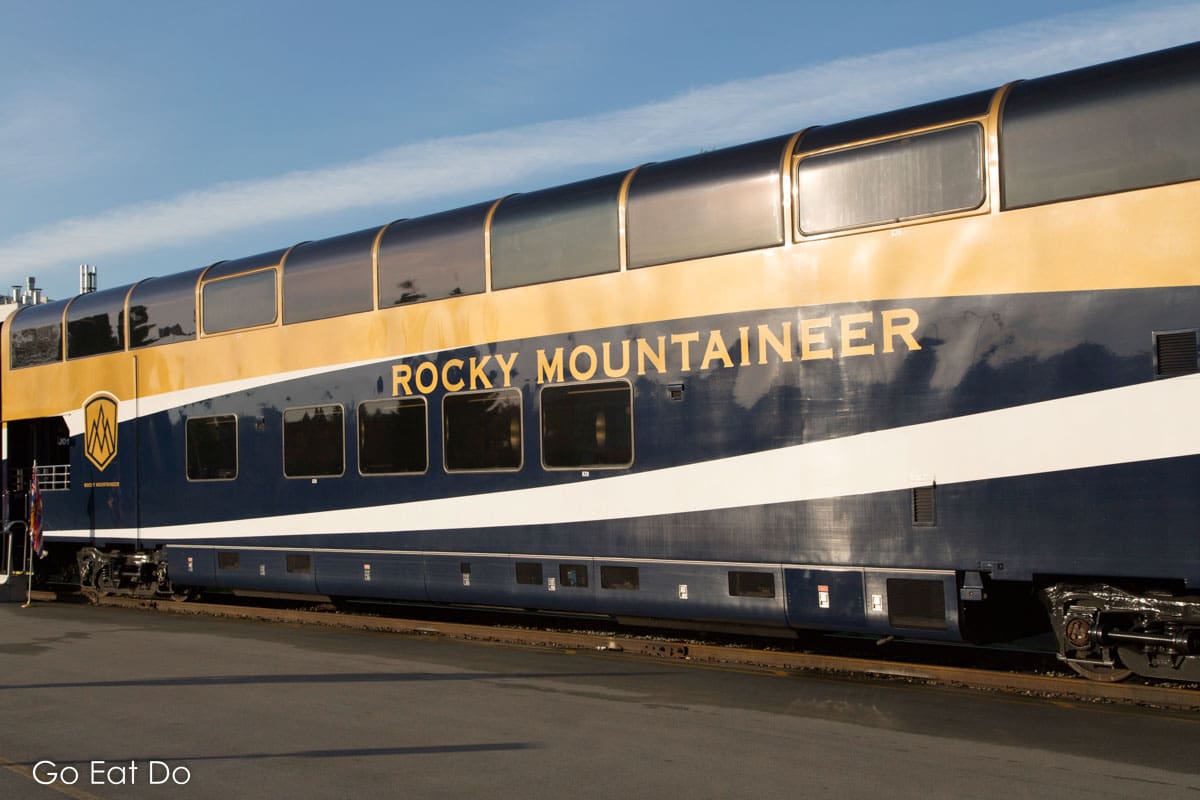
Rocky Mountaineer rail journey
“You cannot make a mistake and forget anything…Everything has a place and there’s a place for everything, as the good old saying goes,” said the chef.
“Everything has to be super well-organised on board the train. You can’t have a messy kitchen. When you do your inventories on a morning you have to know where everything is and how many dozens of eggs, litres of cream and pounds of salmon or beef we have for the day.”
(Overhearing this snippet of the interview playing, my partner couldn’t refrain from commenting that my enthusiastic but disorganised approach to cooking means I’d be no good in one of Jean Pierre’s kitchens.)
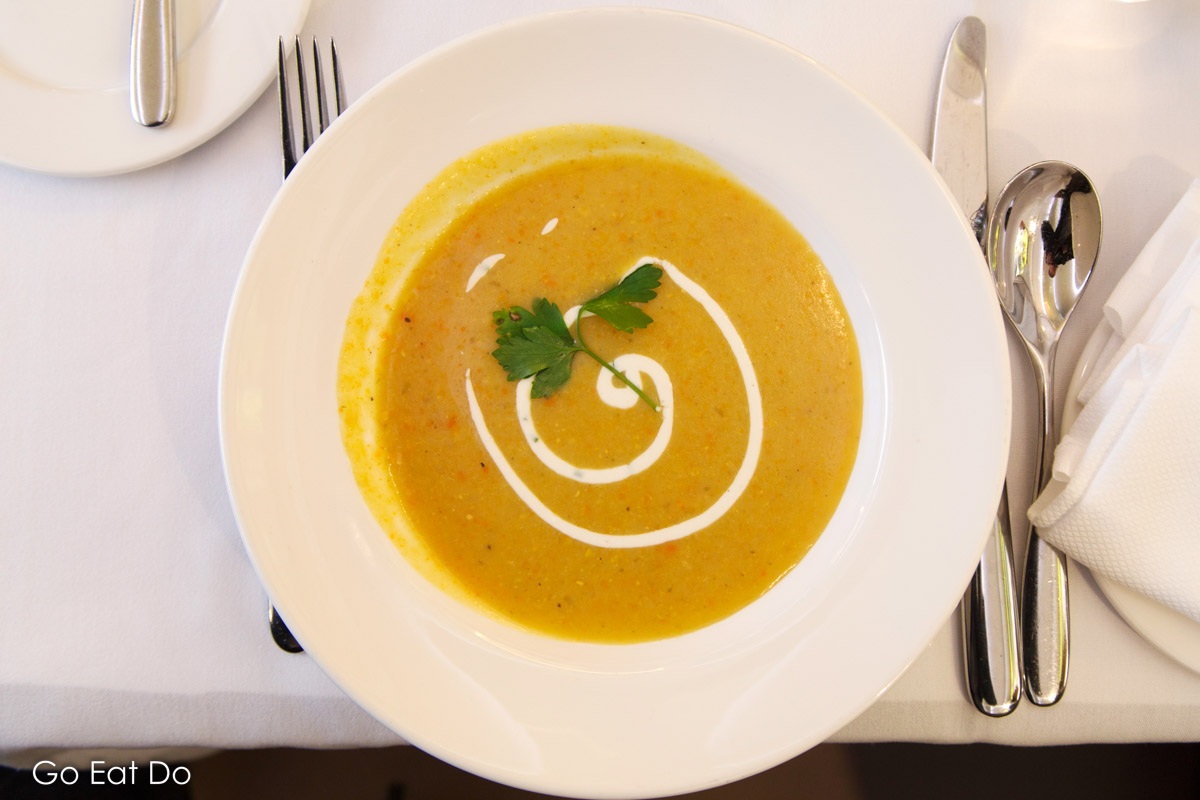
Train cooking
“We have two types of galleys on board the train. They are quite small, compared to restaurant or hotel standards, but well-equipped. But coming from an airline background they are pretty big. The galleys on an aircraft are even smaller but you only have to rethermalise on an aircraft. On a train like the Rocky Mountaineer we do everything. The food you have been served today is cooked fresh on board.
We try to use as much as possible local food supplies. As the growing season comes on we will be using more and more the local British Columbia produce. Most of our protein, like seafood and meat products, is coming in from BC or Alberta,” explained Jean Pierre.
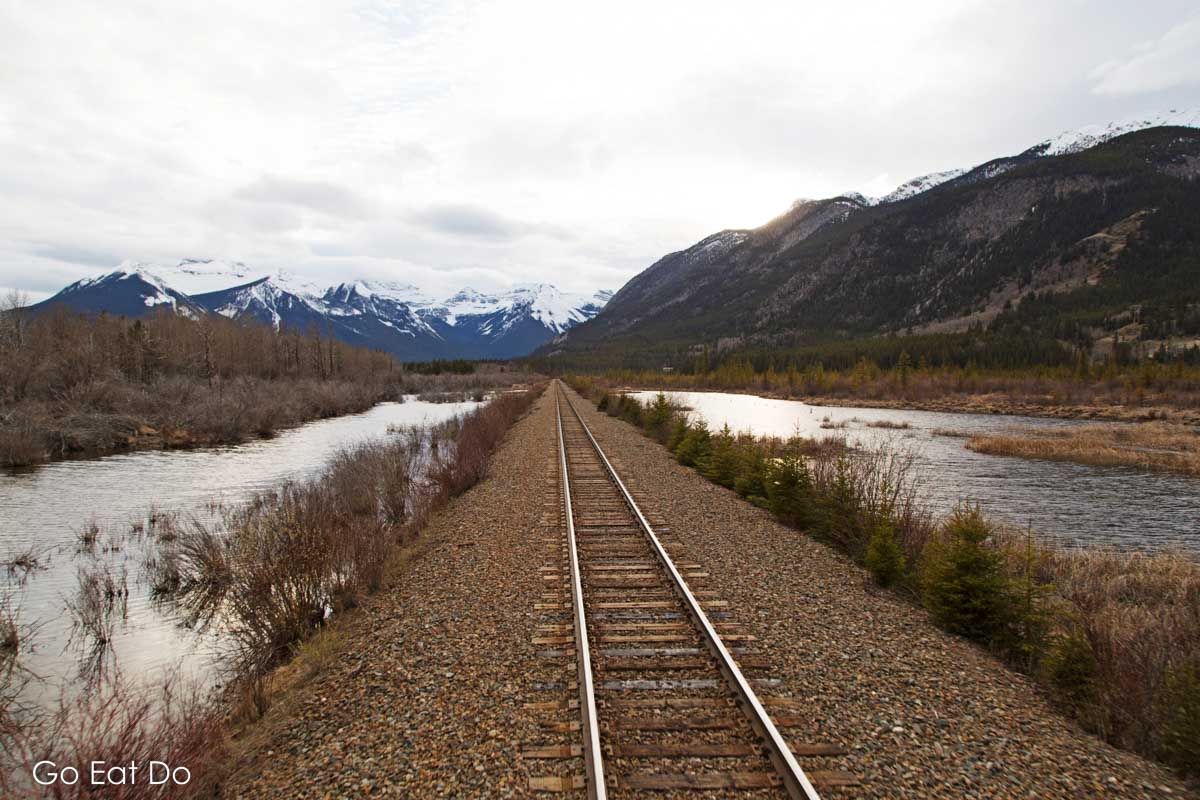
Food service on a train
The logistics of preparing food aboard the Rocky Mountaineer are impressive.
“In a season, we will send out around half a million plates. On an average train, we have around 300 passengers. We will be doing 1,200 to 1,300 plates, including all of the appetisers, the main courses, the desserts and breakfasts.
You have to look at the number of movements we’ll be doing to manufacture that amount of meals. They all have to be consistent. So if you move from one galley to another you’ll see that the same thing happens at the same time.
If you have a beautiful canyon or mountain, that has to be seen. It references us as to when we are going to serve that breakfast or lunch. It would defeat the object of travelling in such a beautiful area if we were to travel late in the day or by night. Everything happens on board with almost a military precision,” said Jean Pierre about the coordination and synchronisation that passengers tend not to notice.
“About 90 per cent of the prep is done on the train. We have a commissary kitchen in Kamloops and we’ll do the stocks and the soups, and some pre-washing of vegetables, as we are limited in the amount of water we can take with us. That water is precious on the train,” he added.

A team of chefs
“All together we have 90 chefs on the Rocky Mountaineer. They are not all travelling together. That takes into account days off and staffing the entire system. Each galley has three chefs. Today we have three in each of the three domed cars and two in the SilverLeaf cars — that’s considered a small train. We have trains where we have 36 to 40 chefs travelling at once.
Each team of three, in the GoldLeaf domes, will serve up to 70 guests. It’s actually quite a busy day,” he said, something that didn’t surprise me after tasting the quality of the meals.
“In SilverLeaf there’s a smaller galley. The food is fresh but you don’t have a choice of five items. There’s a choice of two. There’s no dining room, service is along the aisle on a rolling table to the seats. It’s like the trolleys that were in some First Class airlines during the 1990s. The chef makes the plate in front of the guest. It’s actually very elegant. The big difference between SilverLeaf and GoldLeaf is that you go down to the dining room for GoldLeaf dining,” said Jean Pierre about an aspect of the journey that I enjoyed because it provided opportunities to meet and chat with fellow guests.
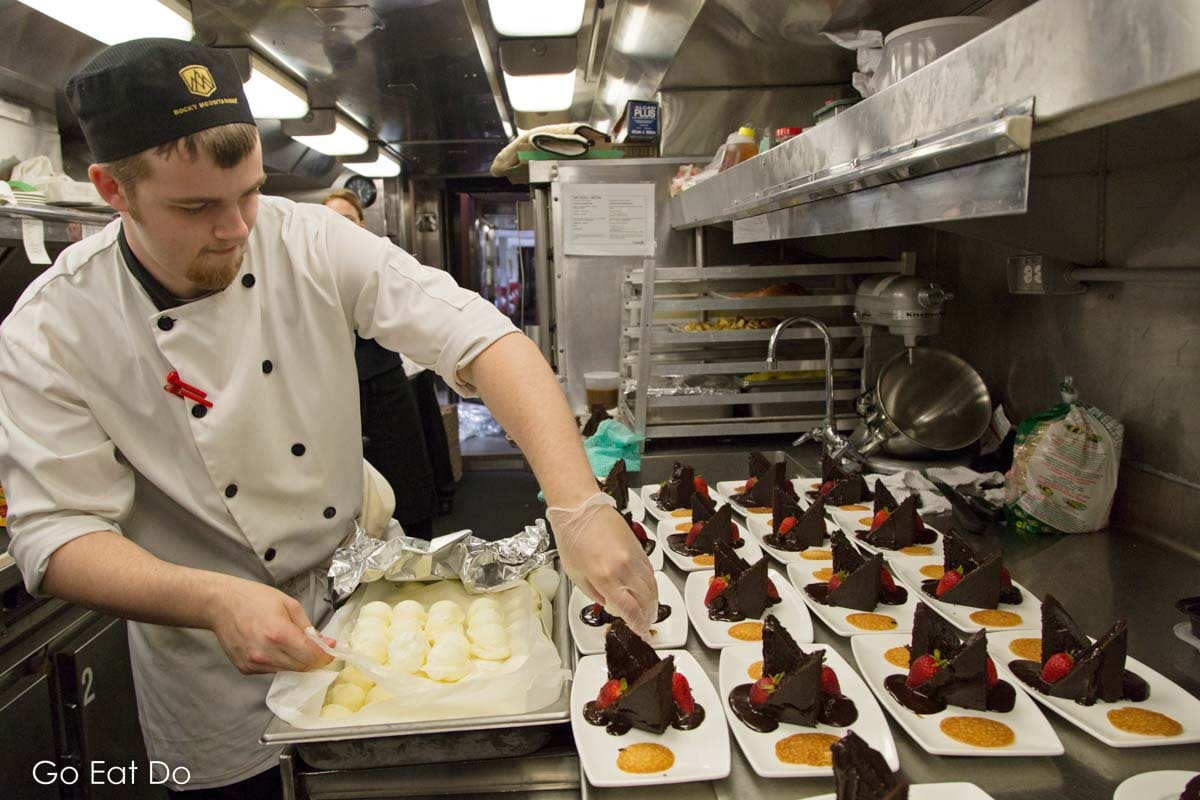
Special dietary requirements
“The chefs have leeway in terms of preparing dishes for guests with special dietary conditions for health, religious or other reasons. There are plenty of ingredients on board and they’ll do pretty much whatever needs to be done to please the guests. Since 2017, our menu has been converted to almost entirely gluten-free. We have so much demand for gluten-free that we have decided to get rid of the wheat items. If we can accommodate people we do,” he said.
“We travel to benchmark ourselves against cruise ships, other trains and restaurants. We like to provide food that is trendy, keeping in mind the environment we work in. At this moment in time, we cannot grill, though we will be able to in the future. We are not allowed to use an open flame —that’s a Transport Canada regulation.
“We have electric stoves…On the new cars we can grill” added the chef.
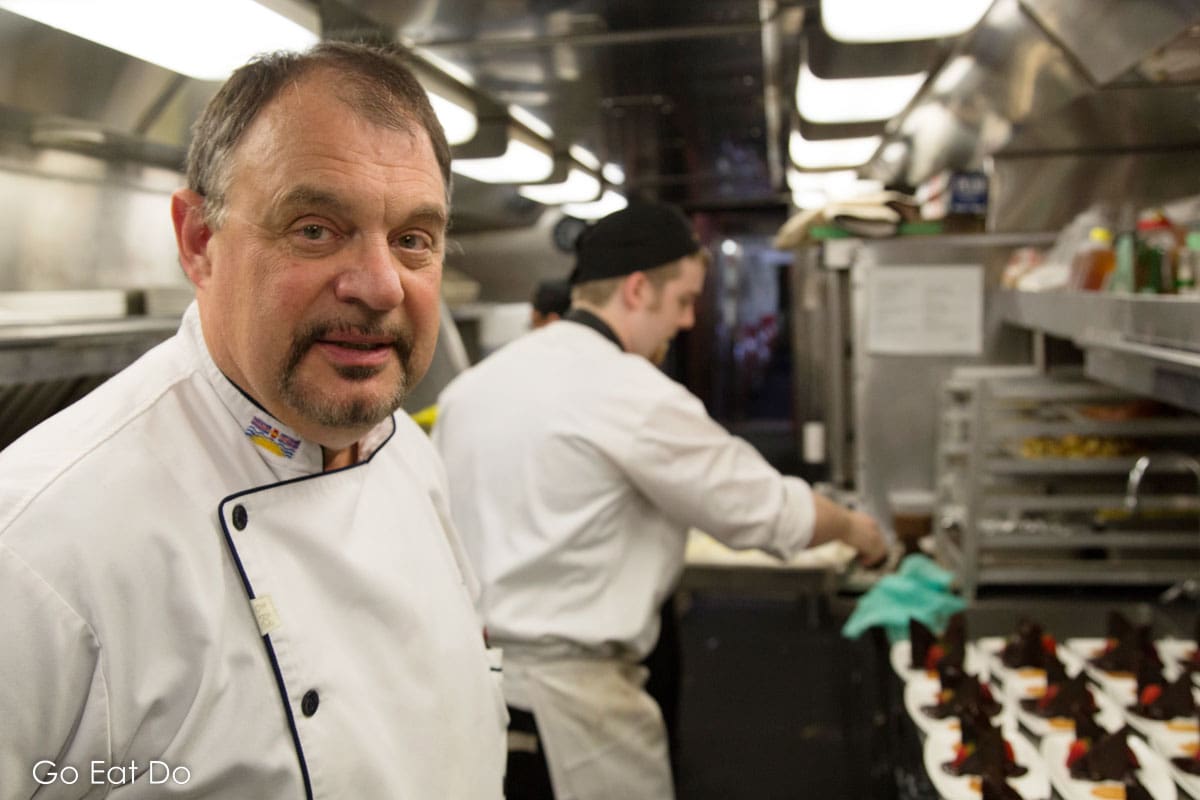
Safety in the kitchen
“Apart from the usual spillage that you’ll have in a kitchen we’ve not had any major disasters that have caused us to stop service. We have strict safety, so there’s not a whole lot of things that can go wrong. When working on a moving platform you have to be careful, especially when handling knives. You have to treat equipment with respect and anticipate what can happen.
We have strict regulations when it comes to cooking. Pots cannot be full for boiling. We can only fill them about halfway, so the water can slosh about. Deep frying is not allowed,” explained Jean Pierre about measures to ensure health and safety in the kitchen.
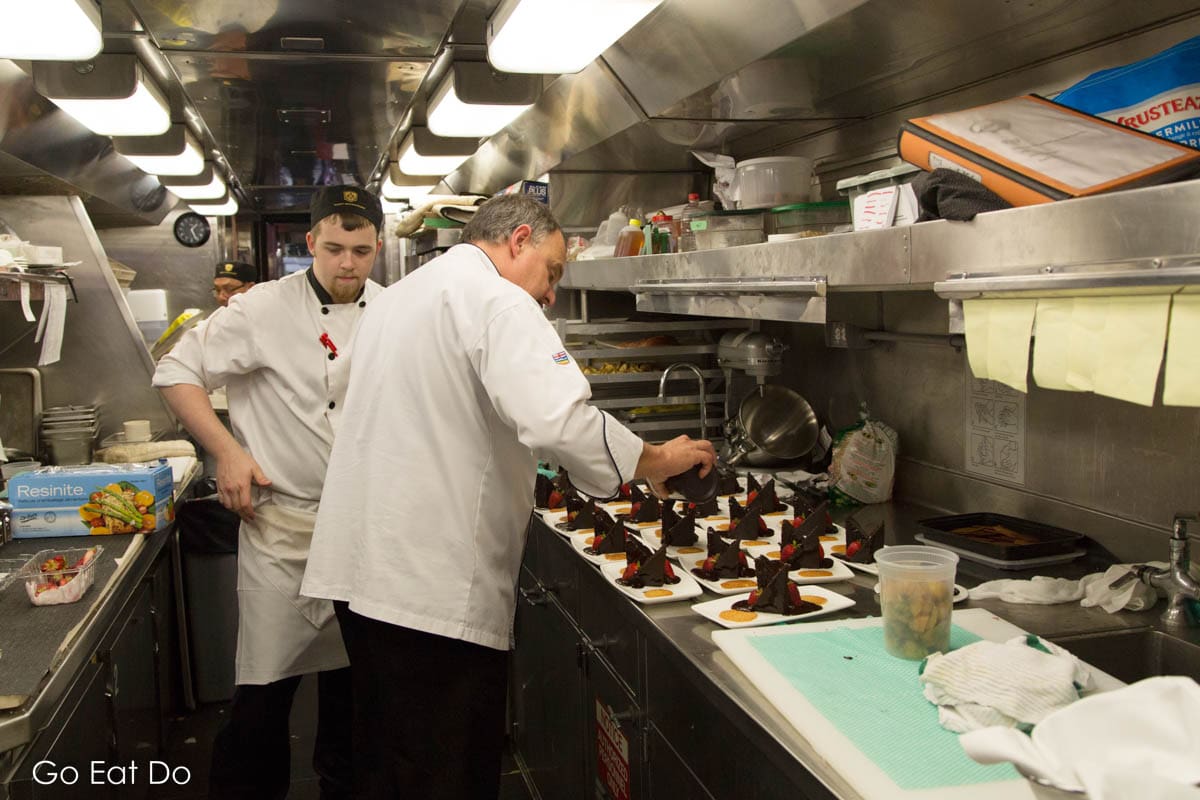
Evolving menus
“Every season we do a brand new menu. We work with our suppliers to see what’s on the market. When something is good, like the Alberta short ribs, we keep them on the menu. They are cooked in wine for a long time. It’s comfort food that isn’t extremely original but I can’t tell you how many hundreds of thousands of portions we’ve served.
We’re not going to remove the winning items each year. We listen to our guests and take their feedback into consideration when developing the menus for the following year,” he said.
That prompted me to ask which dish is most popular among those on the menu. Every menu has a vegetarian option and a light choice. One choice is now always vegan.

Train dining
“This year we have an albacore loin, a white tuna type. It has a very high fat content, lots of flavour and is fished off about 200 kilometres off the shore of British Columbia. It’s a very nice fish and there’s lots of them. That is my favourite this year. It is served with a crisp rice noodle and a sweet soy base. It has been cooked tataki style, surrounded by sesame seeds and raw in the middle.
The breakfast skillet is new. The spinach and feta soufflé is in its second year. Unfortunately, we can’t prepare omelettes — well, we can but only have four burners and it would take too long. We have to think about serving guests in a timely manner, as we have two sittings and we don’t want to be serving breakfast at noon,” said Jean Pierre, who rides the Rocky Mountaineer one or two days a week.
The prospect of doing that is something many travellers, especially those enthusiastic about food, would relish.
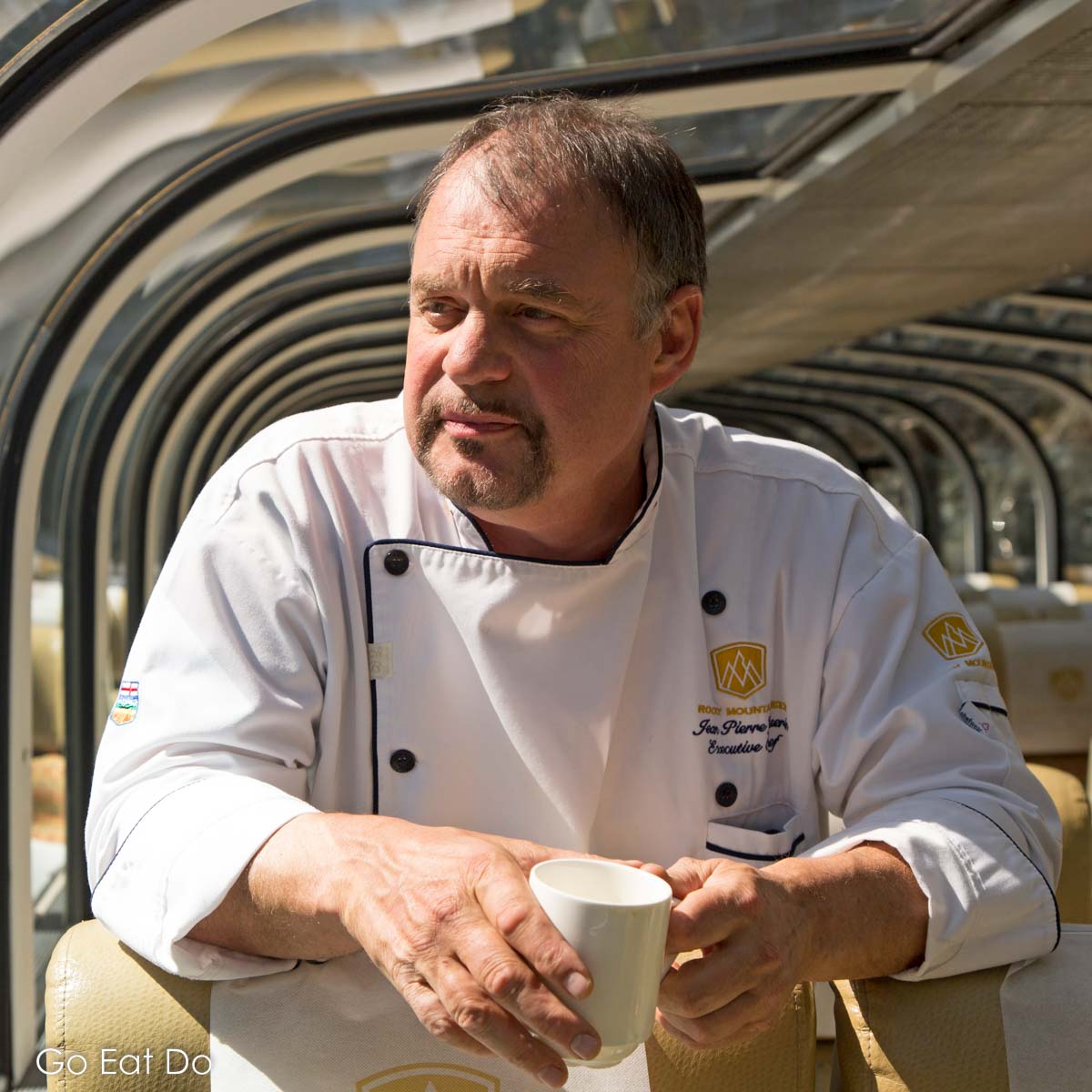
Map of the Rocky Mountaineer Station
The map below shows the location of the Rocky Mountaineer Station in Vancouver, British Columbia:
Hotels in Vancouver, BC
Search for accommodation in Vancouver. British Columbia, on Booking.com:
Books about railways and western Canada
Interested in the Rocky Mountaineer? You can buy the following books from Amazon by clicking on the links or cover photos:
Train Beyond the Mountains: Journeys on the Rocky Mountaineer by Rick Antonson:

Trip of a Lifetime: The Making of the Rocky Mountaineer by Paul Grescoe:


Lonely Planet’s guidebook to British Columbia and the Canadian Rockies:


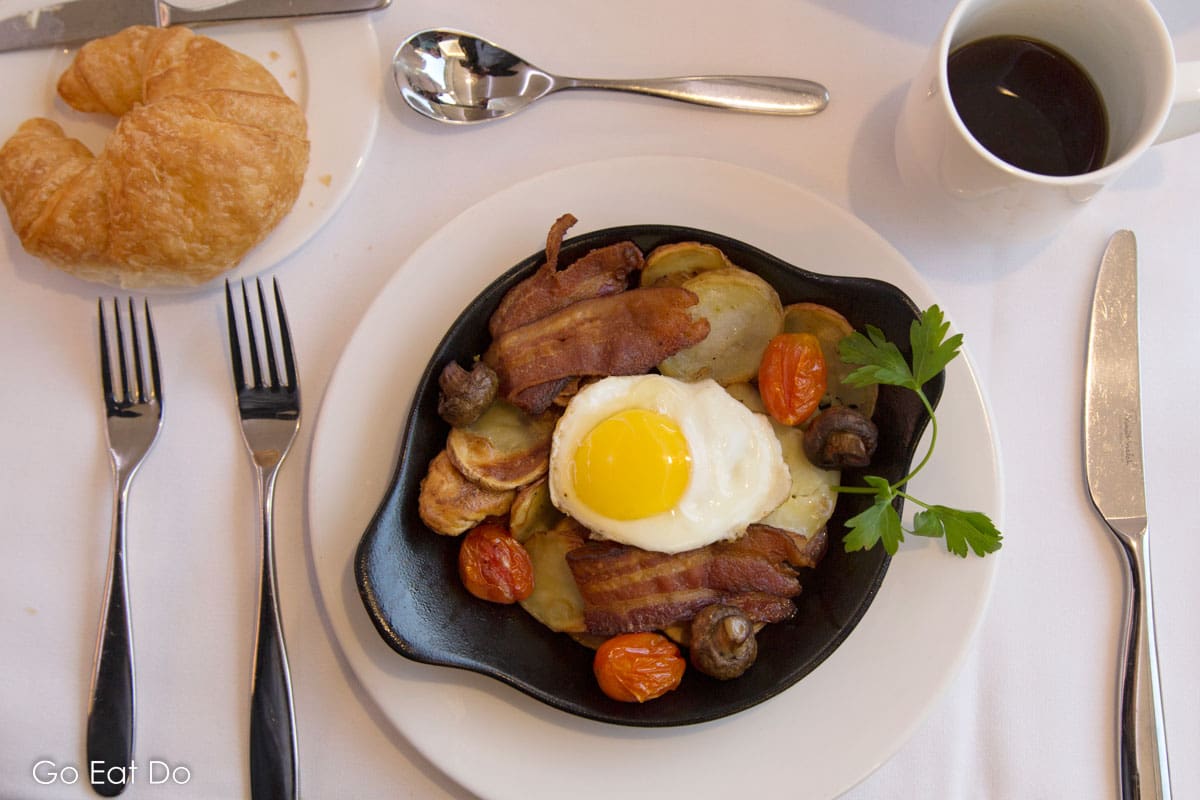
Further information
The Rocky Mountaineer operates four routes, three of them in Canada. The Rainforest to Gold Rush route takes guests between Vancouver and Jasper via Whistler while The Journey Through the Clouds goes via Jasper.
The First Passage to the West is between Vancouver and Banff. The journey is available in GoldLeaf and SilverLeaf classes of service. See the Rocky Mountaineer website or call 0800 0606 7372, free of charge from the United Kingdom, or toll-free on +1-877-460-3200 from North America for details of packages.
See the Destination Canada website for travel information about Canada plus ideas about things to do and see in the country.
Stuart Forster, the author of this post, is an award-winning travel writer with Canada expertise.
Photos illustrating this feature are by Why Eye Photography.
Thank you for visiting Go Eat Do and reading this post about Rocky Mountaineer food and cooking. If you are planning a trip aboard the Rocky Mountaineer, you may enjoy this interview with one of the train managers.
If you enjoyed this post why not sign up for the free Go Eat Do newsletter? It’s a hassle-free way of getting links to posts on a monthly basis.
‘Like’ the Go Eat Do Facebook page to see more photos and content.
A version of this post was initially published on Go Eat Do on 25 June 2017.
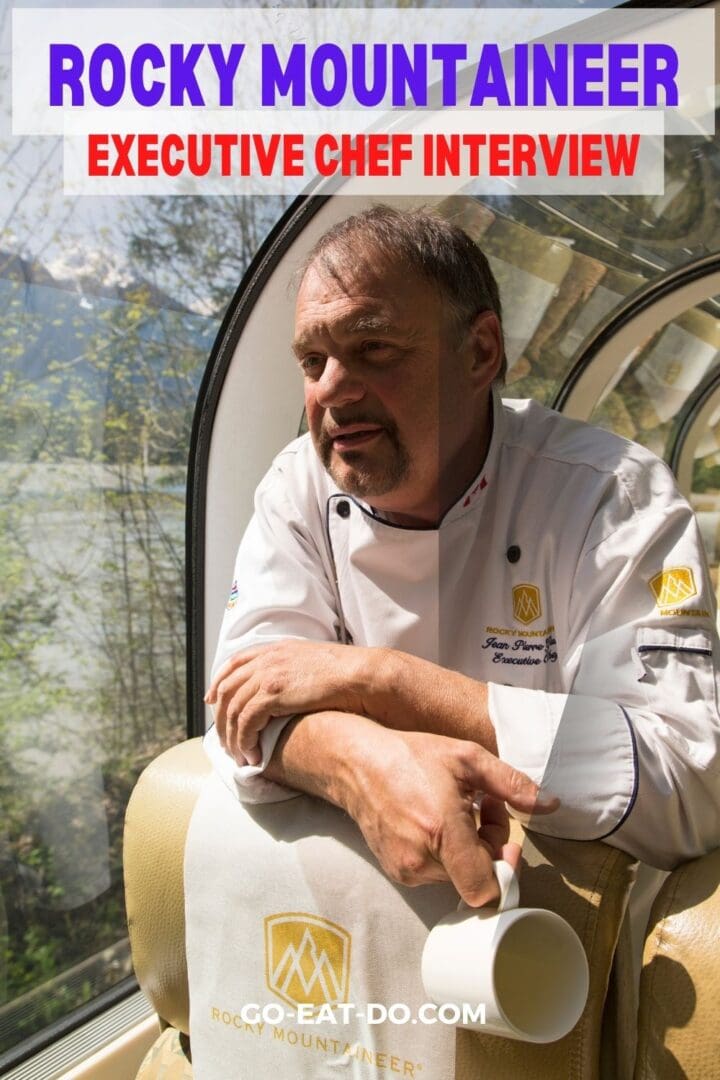



Evan
June 25, 2017 at 19:13As a Canadian, I have never been on this rail journey … looks like I’ll have to tick this one off my bucket list soon, as that food looks unbelievable!
Stuart Forster
June 28, 2017 at 08:40There were a lot of happy passengers. It’s well worth setting aside time to experience.
Darlene Major
July 27, 2017 at 01:34I was on the GoldLeaf journey a week ago… it was great! Food was abundant and wonderful.. as well as the train ride itself! If you haven’t done this… you really should treat yourself. I wish they had routes down here in the USA!!!
Darlene
Stuart Forster
July 27, 2017 at 08:11Hello Darlene, Sounds like you had a great time aboard the Rocky Mountaineer. Seattle features on one of the routes, of course, but I’d certainly love to see the USA from a similar sort of train. Thanks for commenting, Stuart.
Ida carmichael
July 27, 2017 at 07:54We will be visiting Canada again in 2020 and look forward to taking the journey on the Rocky Mountaineer this time setting off from Vancouver.
Stuart Forster
July 27, 2017 at 08:13It’s great that you are thinking ahead and making travel plans. Don’t miss a visit to Stanley Park when you visit Vancouver. I really enjoyed strolling in the park, seeing the totem poles and the views of Vancouver’s high-rise skyline.
Michael O'Leary
July 29, 2017 at 16:45We did the two day journey from Banff to Vancouver. Absolutely outstanding in every respect. Food quality, comfort, service, staff attitude. All wonderful. If you haven’t already done it, do it!
Stuart Forster
July 30, 2017 at 13:35There’s some outstanding scenery on that route. Glad to hear you share my enthusiasm for the experience.
lesley hirst
August 9, 2017 at 19:19I’m coming over from the UK to begin a journey I’ve wanted to do since I was eleven years old, on October 2nd. (Almost 50 years of dreaming…) Having read your article, seen the pictures, and read what the wise M. Guerin has to say, I’m almost hysterical with excitement.
Stuart Forster
August 12, 2017 at 23:40There’s so much in western Canada that will make it a memorable trip. Enjoy!
Cyndi Fodor
August 9, 2017 at 19:27We did Vancouver to Jasper July 25-26 in GoldLeaf service. I was so impressed with the quality and tastes of the gluten free choices…I enjoyed every bite! Thanks for your big part of a great experience. #bucketlisttrip
Stuart Forster
August 12, 2017 at 23:38The cuisine is part of an all round special experience.